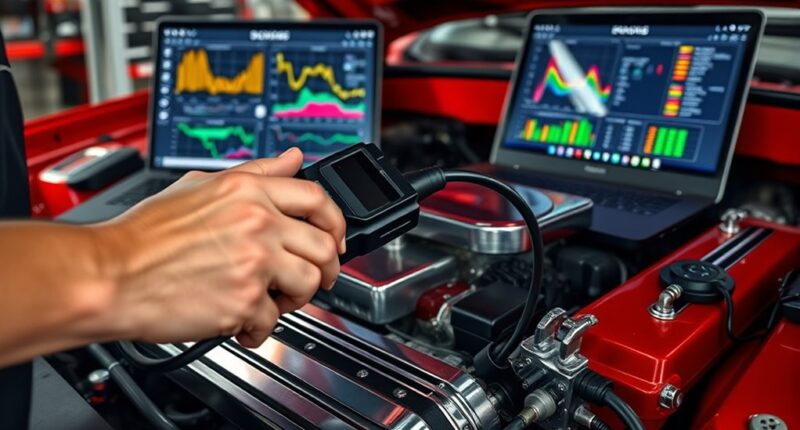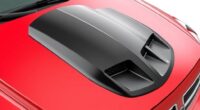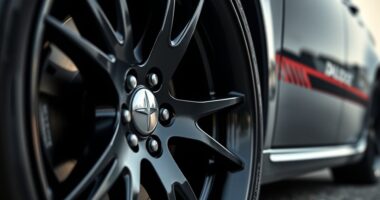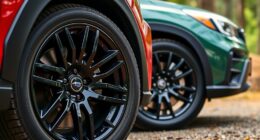ECU tuning for Dodge vehicles involves adjusting parameters like fuel maps, ignition timing, and throttle response to boost power, improve fuel economy, and enhance drivability. Using specialized tools such as HP Tuners or Dodge-specific diagnostic software, you can modify the ECU settings safely. You’ll learn how to optimize air and fuel systems, preserve safety features, and achieve better performance—all while ensuring reliability. Keep exploring to discover how deep tuning can release your vehicle’s full potential.
Key Takeaways
- The ECU manages engine functions like fuel injection, ignition timing, and emissions for optimal performance in Dodge vehicles.
- Tuning involves adjusting parameters such as air-fuel ratio, ignition timing, and boost pressure using specialized tools like HP Tuners.
- Modifying fuel and air systems, including MAF calibration and intake upgrades, enhances power and efficiency.
- Improving throttle response and safety features requires precise ECU adjustments and sensor monitoring.
- Applying broader tuning principles, including cross-model insights, helps achieve smoother, safer, and more effective results.
Understanding the Role of the ECU in Dodge Vehicles
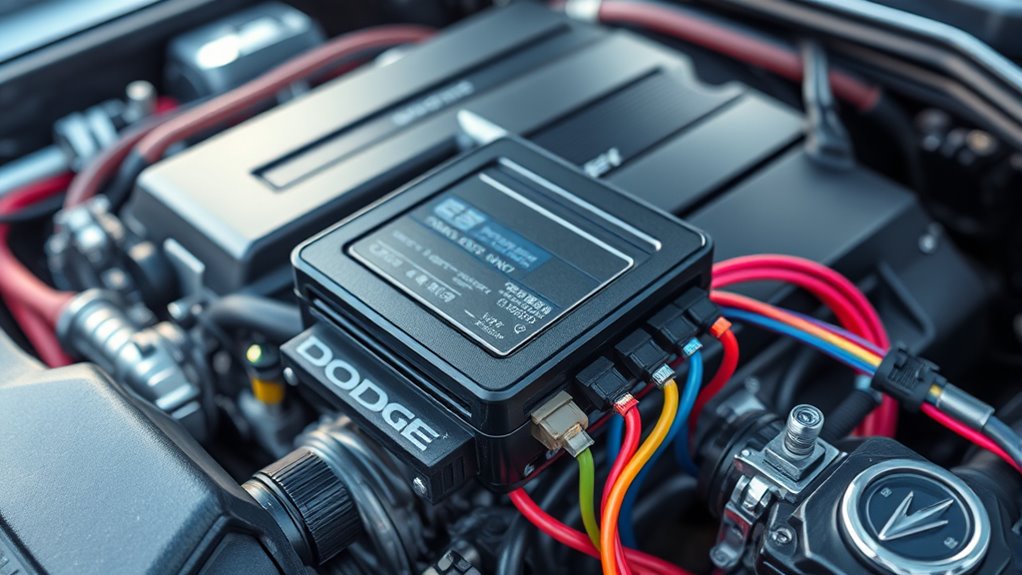
The ECU (Electronic Control Unit) is fundamentally the brain of your Dodge vehicle, responsible for managing key engine functions to guarantee ideal performance. It controls how much fuel gets injected, adjusts ignition timing, and manages emissions to keep your vehicle running smoothly and efficiently. The ECU processes data from sensors like the MAF, O2, TPS, ECT, and VSS, using this information to make real-time adjustments. It acts as a central hub, analyzing inputs to optimize engine power, fuel economy, and emissions. In Dodge vehicles, the ECU works closely with the transmission and other systems to deliver seamless performance. Whether it’s controlling fuel flow or ensuring the engine stays cool, the ECU’s role is essential for reliable and efficient vehicle operation. Additionally, understanding how the ECU works can help you better appreciate ECU tuning and its impact on vehicle performance.
Key Parameters Affected by ECU Tuning
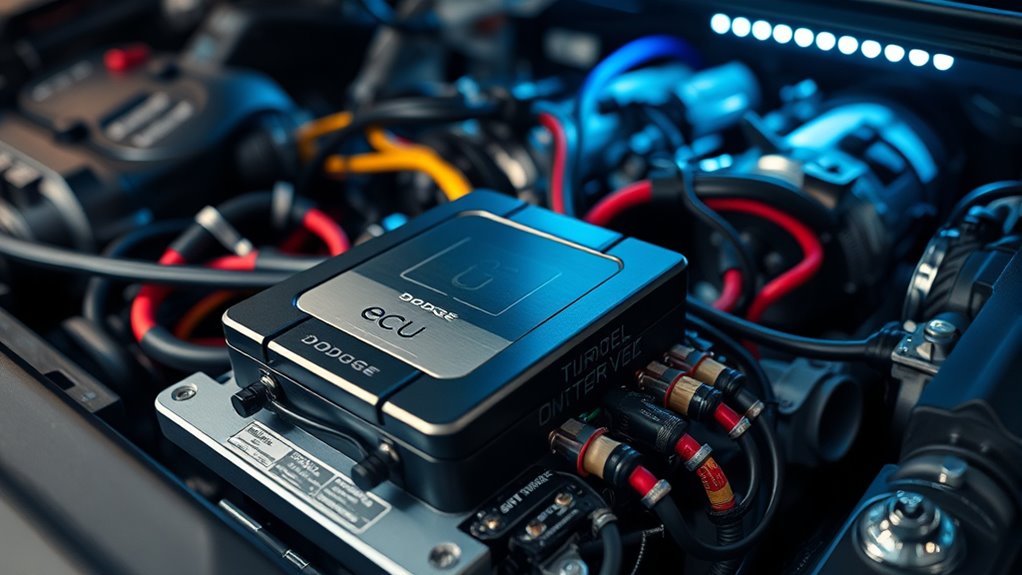
When you tune the ECU of your Dodge, several key engine parameters are adjusted to boost performance, efficiency, and responsiveness. These include the air-fuel ratio, ignition timing, throttle response, boost pressure, and torque curves. Each change fine-tunes engine operation for specific goals like power gains or fuel economy. For example, adjusting fuel maps and idle fueling optimizes fuel delivery, while modifying ignition timing prevents knocking and improves combustion. Additionally, understanding the importance of contrast ratio can help in fine-tuning engine performance for better clarity and detail under different driving conditions. Moreover, recognizing how creative practice influences problem-solving can inspire innovative solutions during the tuning process. Incorporating Hybrid Tuning techniques can further enhance the overall vehicle performance and efficiency. Familiarity with bicycle tire longevity in storage and its influence may provide insight into customizing tuning approaches for specific vehicle models.
Tools and Software for Dodge ECU Calibration

To effectively calibrate your Dodge’s ECU, you need the right tools and software that support precise adjustments and diagnostics. Tools like the wiTech Diagnostic Application allow you to scan and reprogram vehicles using the CAN protocol, while the DRB-III Package provides access to all systems from the mid-90s to 2007. The HP Tuners MPVI3 offers detailed scanning, logging, and calibration for Mopar vehicles, including Dodge. For newer models, the Dodge Smart Access Cable enables read, write, and special functions on 2018+ vehicles. Software options like VCM Suite from HP Tuners facilitate custom calibration creation and performance monitoring. Abrites Diagnostics supports module detection and trouble code reading, making it a versatile choice for various Dodge models. Additionally, understanding the importance of a Gold IRA can help diversify your investment portfolio beyond vehicle tuning. Utilizing diagnostic tools that are compatible with your vehicle ensures accurate calibration and effective vehicle tuning. These tools guarantee accurate calibration and effective vehicle tuning. Moreover, staying updated with the latest software updates ensures compatibility and optimal performance of your calibration tools. Checking for manufacturer-specific protocols can further enhance the precision of your ECU adjustments and ensure optimal vehicle performance.
Common Modifications to Fuel and Air Systems
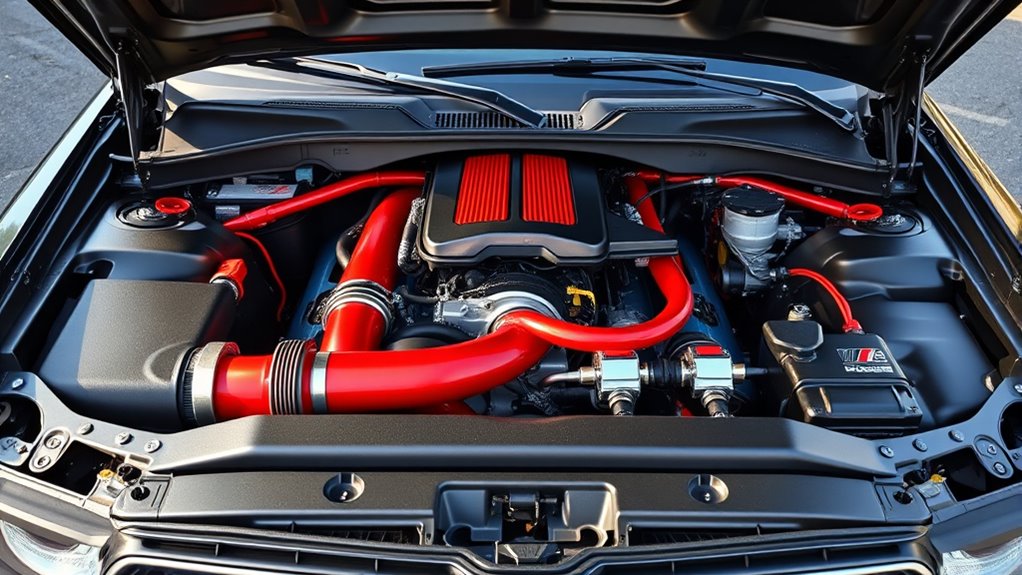
Modifying your Dodge’s fuel and air systems is essential for releasing better performance and efficiency. You can start by adjusting fuel maps to optimize delivery based on air density, temperature, and engine load. Boost pressure management is vital for turbocharged or supercharged engines, ensuring efficient fuel combustion. Fine-tune the air-fuel ratio to maximize power while protecting the engine. Proper fuel pressure management guarantees your system meets engine demands after modifications. Calibrating knock sensors helps prevent knocking or pinging under new fueling conditions. Upgrading the intake system with cold air intakes or high-flow filters increases airflow, improving combustion. Calibrating the MAF sensor and modifying VE tables ensure accurate performance calculations. These modifications set a solid foundation for further tuning and performance gains. Additionally, implementing advanced air purification technology can help maintain optimal air quality within the vehicle’s cabin, contributing to overall engine health and driver comfort. Ensuring your vehicle’s engine management system is properly calibrated can significantly enhance overall tuning precision and reliability. As engine control units become more sophisticated, understanding diagnostic tools can aid in identifying issues early and ensuring your modifications are functioning correctly. Incorporating crochet or fabric decorating techniques in customizing engine covers or interior trims can also add a personalized touch to your vehicle modifications. Regularly monitoring air intake flow and keeping sensors clean can further improve engine response and efficiency.
Adjusting Ignition Timing for Performance and Reliability
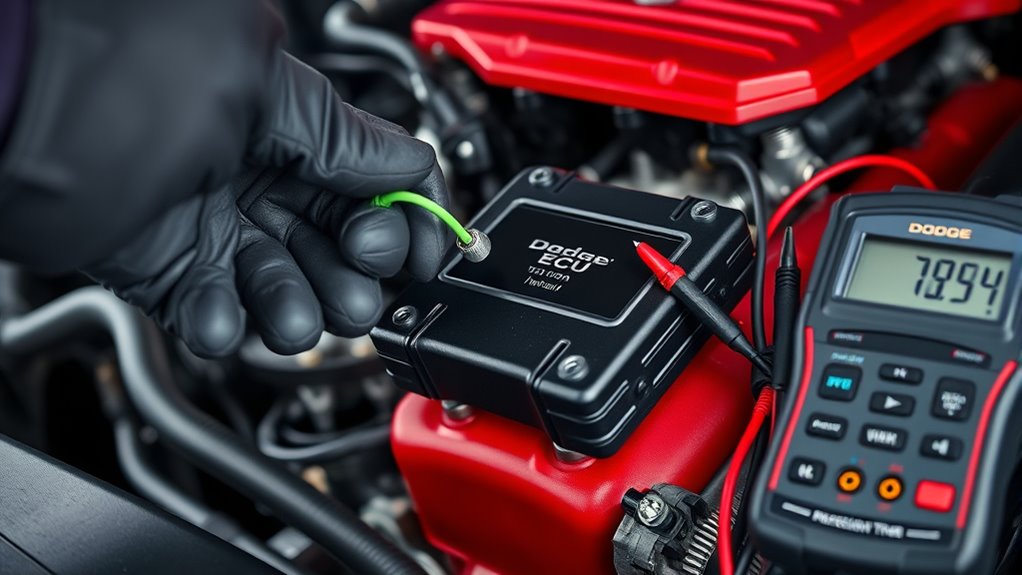
Adjusting ignition timing is a key step in revealing your Dodge’s full performance potential while maintaining engine reliability. Proper timing ensures peak cylinder pressure occurs around 16 to 18 degrees after TDC, optimizing power without risking knock. As engine RPM increases, you need to advance the timing to match faster combustion cycles; at low loads, more ignition advance can be safely used. The ECU monitors sensors like knock sensors to protect your engine, adjusting timing to prevent damage. Advancing timing can boost torque, but overdoing it risks knocking and engine damage. Using tools like HP Tuners, you can refine timing maps for different conditions. Always collect baseline data and make incremental adjustments to find the balance between performance gains and engine safety. Incorporating ECU tuning techniques can further optimize ignition timing for your specific vehicle setup. When tuning, understanding engine dynamics helps in making informed adjustments that enhance both performance and longevity. Additionally, considering sensor feedback ensures your tuning adjustments respond appropriately to engine conditions. Recognizing the importance of proper ignition timing helps prevent issues like misfires and ensures optimal combustion efficiency. Regularly reviewing and adjusting based on performance data can lead to more reliable engine operation over time.
Enhancing Throttle Response and Driveability

Enhancing throttle response and driveability hinges on fine-tuning your Dodge’s Electronic Throttle Control (ETC) system to deliver more immediate and predictable acceleration. By adjusting parameters like pedal sensitivity and throttle voltage, you can reduce lag and make throttle inputs feel more direct. Using software such as HP Tuners allows precise modifications to the throttle settings, improving transient enrichment and fuel tables for better off-idle response. Devices like the PedalBox or Roar Pedal can also provide real-time throttle adjustments, enhancing responsiveness without complex tuning. Tuning for a linear response involves modifying pedal characteristics and torque management tables, resulting in a sportier feel. Additionally, understanding the role of Mazda Tuning principles can help inform better adjustments for smoother throttle behavior. Overall, these adjustments create a more responsive, engaging driving experience while maintaining smoothness and control.
Safety Features and Failsafes in ECU Tuning

When tuning your Dodge’s ECU, it’s crucial to understand that factory safety features are designed to protect your engine and drivetrain from damage, even during modifications. Knock detection systems stay active to prevent damaging detonation, while overboost protection guards turbocharged engines against excessive pressure. Limp mode activates if critical failures occur, preserving essential components. Fail-safe fuel maps automatically revert to conservative settings if errors happen, and real-time sensor monitoring keeps OEM diagnostics functional for early fault detection. The tuning process itself includes safeguards like non-invasive OBD-II programming, pre-tune diagnostics, and dyno testing to verify air-fuel ratios. Incremental adjustments and backup restoration points help avoid sudden stress on parts. These features ensure you can modify your vehicle safely without risking engine damage or voiding warranties.
Achieving Performance Gains and Fuel Efficiency
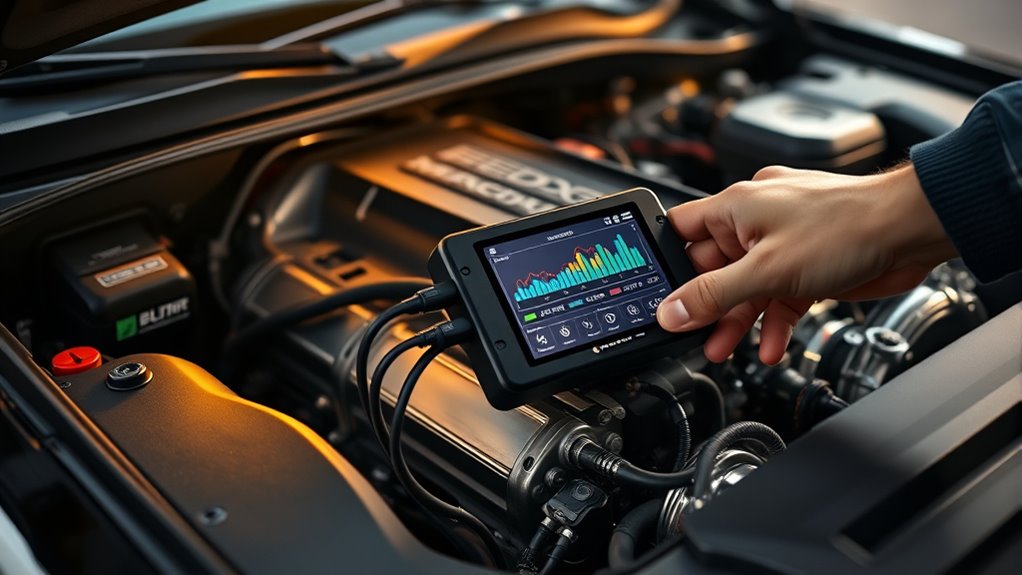
Achieving performance gains and improving fuel efficiency with your Dodge’s ECU tuning involves selecting the right hardware and understanding how modifications influence your vehicle’s behavior. By choosing the appropriate performance chip, you can unlock horsepower and torque increases, enhancing acceleration and driving responsiveness. Additionally, these chips optimize engine parameters like air-fuel mixture and ignition timing, which can lead to better fuel economy. To maximize benefits, consider these key points:
- Pick a high-quality, plug-and-play chip designed for your Dodge model.
- Use tuning that balances performance improvements with fuel efficiency.
- Take advantage of dynamic adjustments that adapt to driving conditions.
With the right approach, ECU tuning delivers immediate performance boosts while saving you fuel costs over time.
Frequently Asked Questions
Can ECU Tuning Void My Dodge Vehicle’S Warranty?
So, you’re wondering if ECU tuning will void your Dodge’s warranty? Ironically, it often does, especially if the dealer detects it during service. While a tune might boost performance, it can also void your warranty if it affects emissions or engine safety. Some manufacturers offer approved tunes, but if you go rogue, be prepared for potential claim denials. Think twice before risking that warranty for a little extra power.
Is It Possible to Revert to Stock ECU Settings After Tuning?
Yes, you can revert to stock ECU settings after tuning. You’ll need to use specific software to reflash the ECU with the original factory firmware. Make sure to backup your current settings before starting. Follow the proper reversion procedures carefully to avoid errors, and perform diagnostic checks afterward. Keep records of the process, and consider professional help if you’re unsure, to ensure a clean and successful reversion.
How Long Does an ECU Tuning Process Typically Take?
The ECU tuning process typically takes anywhere from a few hours to a full day, depending on the complexity of the tune and your vehicle’s modifications. You’ll start with an initial assessment, then move on to hardware and software setup. Re-flashing the ECU and making adjustments can take several hours, especially if multiple iterations are needed. Post-tuning, your vehicle may require some driving time for full adaptation.
Will Tuning Affect My Vehicle’S Emissions Compliance?
Ever wonder if tuning your vehicle is just a sneaky way to dodge emissions laws? Well, it can be—unless you choose a tune that’s approved by authorities like CARB. Certain tunes maintain compliance, but many modifications risk failing smog checks and legal standards. So, if you care about legality and the environment, pick a tune designed for compliance, and don’t turn your ride into a rebellious smoke machine.
What Are the Risks of Improper ECU Calibration?
Improper ECU calibration can pose serious risks to your vehicle. You might experience engine wear, reduced reliability, or even catastrophic failures like engine seizures. It can cause erratic performance, increased emissions, or overheating, leading to costly repairs. Plus, improper tuning could void your warranty and decrease your vehicle’s resale value. If you don’t have the right expertise, you risk damaging components or creating unsafe driving conditions.
Conclusion
By tuning your Dodge’s ECU, you open a world where horsepower and efficiency seamlessly blend—like a well-orchestrated engine humming smoothly through a quiet night. As you tweak parameters and upgrade systems, you’ll find yourself cruising with confidence, the road unfolding before you like a canvas awaiting your personal touch. Remember, every adjustment is a step toward turning your vehicle into a true reflection of your driving passion, where performance and reliability meet in perfect harmony.
